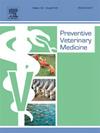Impact of owners’ perception and socioeconomic status on the treatment and clinical outcome of mammary neoplasms in female dogs
IF 2.4
2区 农林科学
Q1 VETERINARY SCIENCES
引用次数: 0
Abstract
Mammary neoplasms are common in female dogs, so early diagnosis, appropriate medical intervention, and owner compliance are crucial for effective treatment and an improved quality of life. This study aimed to investigate the spatial epidemiology of mammary tumors in female canines and explore their relationship with owner demographics and attitudes toward pet care. A prospective cohort study was conducted at a University Veterinary Hospital, where clinical data were collected throughout the treatment process. Histopathological evaluations were performed for most patients undergoing mastectomy. The Knowledge, Attitude, and Practice (KAP) methodology was employed to interview owners before and after clinical examinations of their dogs presenting with mammary lesions. Spatial analysis was conducted using QGIS software to assess clinical findings, survival rates, and owners’ demographic and socioeconomic information. In the study, a total of 66 tumors were identified in 66 female dogs. The results indicated that unspayed, mixed-breed females, with an average age of 10 years, were the most affected, with 95 % of tumors classified as malignant. The mean delay between owner detection and veterinary consultation was 210 days. Regarding socioeconomic factors, 35 % of owners earned the minimum wage, while only 9 % earned more than six times the minimum wage. Concerning educational attainment, 52 % of participants had completed secondary education, and 35 % held a university degree. The findings demonstrated that income and education levels significantly influenced treatment adherence. Female owners, who comprised 66 % of respondents, exhibited greater knowledge of cancer risk factors and were more proactive in seeking veterinary care. Additionally, greater distance from the Veterinary University Hospital was associated with larger tumor size, higher malignancy rates, and longer detection times, highlighting the importance of targeted educational initiatives to promote early detection and treatment of mammary neoplasms in female dogs.
饲主观念和社会经济地位对雌性犬乳腺肿瘤治疗和临床结果的影响
乳腺肿瘤在母狗中很常见,因此早期诊断、适当的医疗干预和主人的依从对于有效治疗和改善生活质量至关重要。本研究旨在探讨雌性犬乳腺肿瘤的空间流行病学特征,并探讨其与饲主人口统计学特征和宠物护理态度的关系。在一所大学兽医医院进行了一项前瞻性队列研究,在整个治疗过程中收集临床数据。对大多数接受乳房切除术的患者进行了组织病理学评估。采用知识、态度和实践(KAP)方法,在狗狗出现乳腺病变的临床检查前后对其主人进行访谈。使用QGIS软件进行空间分析,以评估临床表现、生存率以及业主的人口统计学和社会经济信息。在这项研究中,66只雌性狗共发现了66个肿瘤。结果表明,平均年龄为10岁的未阉割的杂交雌性受影响最大,95% %的肿瘤被归类为恶性肿瘤。从主人发现到兽医咨询的平均延迟时间为210天。在社会经济因素方面,35% %的业主赚取最低工资,而只有9% %的业主赚取超过最低工资的六倍。在教育程度方面,52% %的参与者完成了中等教育,35% %的参与者拥有大学学位。研究结果表明,收入和教育水平显著影响治疗依从性。女性饲主占受访者的66% %,她们对癌症风险因素的了解程度更高,也更积极主动地寻求兽医护理。此外,距离兽医大学医院越远,肿瘤大小越大,恶性肿瘤发病率越高,检测时间越长,这突出了有针对性的教育举措的重要性,以促进雌性犬乳腺肿瘤的早期发现和治疗。
本文章由计算机程序翻译,如有差异,请以英文原文为准。
求助全文
约1分钟内获得全文
求助全文
来源期刊

Preventive veterinary medicine
农林科学-兽医学
CiteScore
5.60
自引率
7.70%
发文量
184
审稿时长
3 months
期刊介绍:
Preventive Veterinary Medicine is one of the leading international resources for scientific reports on animal health programs and preventive veterinary medicine. The journal follows the guidelines for standardizing and strengthening the reporting of biomedical research which are available from the CONSORT, MOOSE, PRISMA, REFLECT, STARD, and STROBE statements. The journal focuses on:
Epidemiology of health events relevant to domestic and wild animals;
Economic impacts of epidemic and endemic animal and zoonotic diseases;
Latest methods and approaches in veterinary epidemiology;
Disease and infection control or eradication measures;
The "One Health" concept and the relationships between veterinary medicine, human health, animal-production systems, and the environment;
Development of new techniques in surveillance systems and diagnosis;
Evaluation and control of diseases in animal populations.
 求助内容:
求助内容: 应助结果提醒方式:
应助结果提醒方式:


